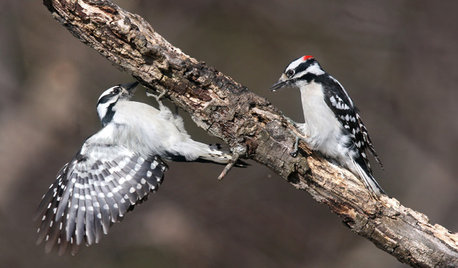Help identify azalea problems
knepper3
18 years ago
Related Stories

GARDENING FOR BIRDSBackyard Birds: How to Identify Two Common Woodpeckers
Downy and hairy woodpeckers have similar coloration and behavior. But there are two big differences that separate them
Full Story
DECORATING GUIDESCould a Mission Statement Help Your House?
Identify your home’s purpose and style to make everything from choosing paint colors to buying a new home easier
Full Story
FEEL-GOOD HOMEBack Problems? Try Putting Your Feet Up
Consider these alternatives to that one-size-doesn’t-fit-all sofa to avoid slumping and spinal stress
Full Story
HOUSEKEEPING10 Problems Your House May Be Trying to Show You
Ignore some of these signs and you may end up with major issues. We tell you which are normal and which are cause for concern
Full Story
ORGANIZINGGet the Organizing Help You Need (Finally!)
Imagine having your closet whipped into shape by someone else. That’s the power of working with a pro
Full Story
EARTH DAYHow to Help Your Town’s Beneficial Birds and Bugs
Make a habitat using local materials to provide a home to the creatures that help our gardens
Full Story
LIFEDecluttering — How to Get the Help You Need
Don't worry if you can't shed stuff and organize alone; help is at your disposal
Full Story
SELLING YOUR HOUSEHelp for Selling Your Home Faster — and Maybe for More
Prep your home properly before you put it on the market. Learn what tasks are worth the money and the best pros for the jobs
Full Story
DECLUTTERINGDownsizing Help: How to Edit Your Belongings
Learn what to take and what to toss if you're moving to a smaller home
Full Story
ORGANIZING4 Questions to Help You Organize Your Favorite Photos
Organize your keeper photos with a system that's just right for you, whether it's in the cloud or you can hold it in your hand
Full StorySponsored
Industry Leading Interior Designers & Decorators in Franklin County






morz8 - Washington Coast
rhodyman
Related Professionals
Danbury Landscape Architects & Landscape Designers · Alexandria Landscape Contractors · Addison Landscape Contractors · Biloxi Landscape Contractors · Brooklyn Park Landscape Contractors · Commack Landscape Contractors · Fair Lawn Landscape Contractors · Norristown Landscape Contractors · North Ridgeville Landscape Contractors · Olympia Landscape Contractors · Pahrump Landscape Contractors · Soddy Daisy Landscape Contractors · St. Louis Landscape Contractors · Tacoma Landscape Contractors · Watertown Landscape Contractorsluis_pr
yworthington_mac_com
rhodyman
bobbiemcdermid_aol_com
smaslen_verizon_net
rhodyman